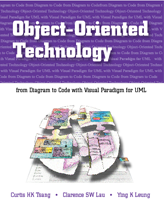Object-Oriented Technology: from Diagram to Code with Visual Paradigm for UML
Learn more practical skills in software development?
- Paperback: 456 pages
- Publisher: McGraw-Hill Science/Engineering/Math; 1st edition (April 26, 2005)
- ISBN: 0071240462
Sample Chapters are available for download.
Including:
Chapter 2 - Structural Modeling and Analysis, &
Chapter 3 - Use Case Modeling and Analysis.
Format: Zipped PDF
Size: 982 KB
We are pleased to announce that the three people closely involved in the development of the VP-UML CASE tool have coauthored a textbook entitled, "Object Oriented Technology: from diagram to code with Visual Paradigm for UML". The book, which is published by McGraw Hill, is now available in bookstores.
This book is written for students and developers who wish to master the essential skills and techniques in applying the UML for software development. The reader will learn object-oriented analysis, design and implementation using appropriate UML models, process, techniques and tools. Accompanying the book is the Community Edition of Visual Paradigm for UML (VP-UML), an award winning CASE tool, which allows the reader to put the theories learned into practice immediately.
The authors propose a novel framework for modeling and analysis called the View Alignment Techniques (VAT) that helps software developers create development methods. The Activity Analysis Approach (A3), which is particularly suited for the development of interaction-intensive systems, is described in detail in this book. These concepts have been well proven, as they were followed closely in the development of the VP-UML CASE tool.
Table of Content
Chapter 1 Introduction
- Overview
- What You Will Learn
- Software Engineering Approaches
- Visual Modeling
- Software Development Methods
- Representation, Process Techniques and Tool
- Organization of the Book
- Summary
Chapter 2 Structural Modeling and Analysis
- Overview
- What You Will Learn
- What is an Object?
- What is a Class and What are Instances?
- Structural Modeling Techniques
- Structural Models: Examples
- Summary of the UML Notation for Structural Modeling
- Structural Analysis Techniques
- Domain Modeling and Analysis Process
- Tricks and Tips in Structural Modeling and Analysis
- Domain Modeling and Analysis with VP-UML
- Summary
- Exercise
Chapter 3 Use Case Modeling and Analysis
- Overview
- What You Will Learn
- Requirements Elicitation
- Use Case Modeling Techniques
- Use Case Models: Examples
- Use Case Analysis Techniques
- The Use Case Modeling and Analysis Process
- Tricks and Tips in Using Case Analysis
- Use Case Modeling and Analysis with VP-UML
- Summary
- Exercise
Chapter 4 Dynamic Modeling and Analysis
- Overview
- What You Will Learn
- Scenario Modeling Techniques - Interaction Diagram
- Examples of Scenario Modeling
- Dynamic Modeling Techniques Using Statechart Diagrams
- Dynamic Modeling Techniques Using Activity Diagrams
- Dynamic Analysis Techniques
- Dynamic Modeling and Analysis Process
- Tricks and Tips in Dynamic Modeling and Analysis
- Dynamic Modeling and Analysis with VP-UML
- Summary
- Exercise
Chapter 5 Implementing UML Specification
- Overview
- What You Will Learn
- Introduction
- Implementing Class Diagrams
- Implementing Persistent Classes using Relational Databases
- Implementing Activity Diagrams
- Implementing State Diagrams
- Implementing Interaction Diagrams
- Case Study: A Lift Control System
- Summary
- Exercise
Chapter 6 View Alignment Techniques and Method Customization
- Overview
- What You Will Learn
- Software Development Methods
- Why Traditional Software Methods Didn't Work Miracles?
- Unified Modeling Language (UML) vs Software Methods
- Hurdles in Applying the Object-oriented Approach
- Current Object Oriented Development Approach
- View Alignment Techniques (VAT)
- Method Creation or Customization Using View Alignment Techniques
- Method Creation: A Case Study
- Summary
- Exercise
Chapter 7 A Case Study: Applying the Activity Analysis Approach
- Overview
- What You Will Learn
- The Case Study
- Business Modeling
- Requirements
- Analysis
- Design
- Applying the Activity Analysis Approach with VP-UML
- Summary
Appendix A Getting Started with VP-UML
- Installing VP-UML
- The VP-UML Environment
- Working with Diagrams
- Creating Diagram Elements
- Resource-centric Interface
- Diagram Element Properties
- Sub-Diagrams
- Code Generation
- Textual Analysis
- Report Generation
- Importing Models/Diagrams
Appendix B Basic UML Concepts
- Relationship between UML Diagrams
Appendix C Implementation of the Lift Control System in Chapter 5
References
Index


